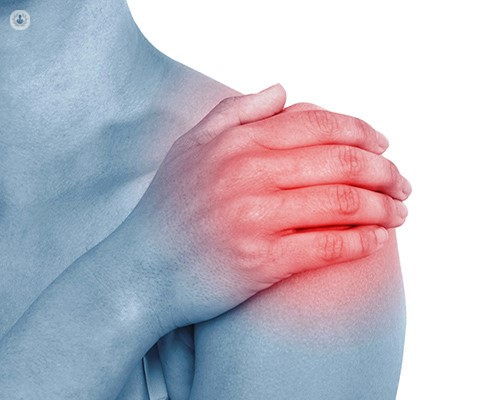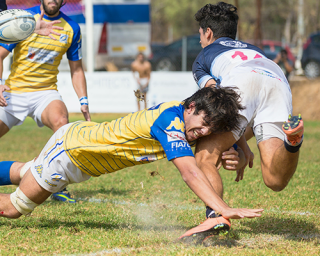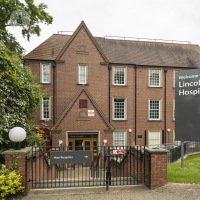What is a fractured (broken) shoulder?
A shoulder fracture is a break or a crack in one of the three following bones; the clavicle, scapula or the proximal humerus. In the latter case, it would be called a broken shoulder. The humerus can be broken in many places and the fracture is normally described by its location.
Shoulder fractures often result from a sudden force applied on the arm, such as from a serious fall, when playing contact sports, or as the result of a car accident.

What is the anatomy of the shoulder?
The shoulder is made up of three bones: the scapula (shoulder blade), clavicle (collar bone) and the humerus (the arm bone).
The three bones are joined together by ligaments, tendons, muscles and joint capsule in order for the arm to work.
The shoulder is made up of three joints: glenohumeral joint (the main joint), acromioclavicular joint and the sternoclavicular joint.
What are the causes of a fractured shoulder?
Fractures of the clavicle or proximal humerus are most commonly caused by a direct blow to the area from a fall, collision or motor vehicle accident. The scapula is protected by the chest and surrounding muscles and therefore is not easily broken. Fractures of the scapula are normally caused by high-energy trauma, such as a high-speed motor vehicle accident. They are also associated with injuries to the chest.
What are the symptoms of a fractured shoulder?
General symptoms of a fractured shoulder include pain, swelling and bruising, an inability to move the shoulder, a grinding sensation when the shoulder moves and that it does not look right. It depends on which of the three bones in the shoulder are fractured for specific symptoms.
How is a fractured shoulder diagnosed?
Fractures are diagnosed by the use of an X-ray and by physical examination.
How are shoulder fractures treated?
Treatment depends on which of the three bones has become fractured:
- Clavicle (collarbone) fractures – These fractures are usually treated without surgery. Surgery is required when a fracture has broken through the skin or the bone is out of place. It is fixed with plates, screws or rods inside the bone.
- Proximal humerus (arm bone) fractures – Most fractures of the proximal humerus are left without surgery if the bones are not displaced. If they are out of position, surgery is necessary and involves fixation of the fracture fragments with plates, screws, or pins. In some cases, it involves shoulder replacement.
- Scapula (shoulder blade) fractures – Most are treated without surgery. Treatment includes using a sling, icing and pain medications. Fractures that need surgery usually have fracture fragments involving the shoulder joint, or there is an additional fracture of the collarbone. Surgery includes plates and screws for fixation.
Fractured shoulder
Mr Charles Jeremy S Corbin - Orthopaedic surgery
Created on: 11-13-2012
Updated on: 03-29-2023
Edited by: Jay Staniland
What is a fractured (broken) shoulder?
A shoulder fracture is a break or a crack in one of the three following bones; the clavicle, scapula or the proximal humerus. In the latter case, it would be called a broken shoulder. The humerus can be broken in many places and the fracture is normally described by its location.
Shoulder fractures often result from a sudden force applied on the arm, such as from a serious fall, when playing contact sports, or as the result of a car accident.

What is the anatomy of the shoulder?
The shoulder is made up of three bones: the scapula (shoulder blade), clavicle (collar bone) and the humerus (the arm bone).
The three bones are joined together by ligaments, tendons, muscles and joint capsule in order for the arm to work.
The shoulder is made up of three joints: glenohumeral joint (the main joint), acromioclavicular joint and the sternoclavicular joint.
What are the causes of a fractured shoulder?
Fractures of the clavicle or proximal humerus are most commonly caused by a direct blow to the area from a fall, collision or motor vehicle accident. The scapula is protected by the chest and surrounding muscles and therefore is not easily broken. Fractures of the scapula are normally caused by high-energy trauma, such as a high-speed motor vehicle accident. They are also associated with injuries to the chest.
What are the symptoms of a fractured shoulder?
General symptoms of a fractured shoulder include pain, swelling and bruising, an inability to move the shoulder, a grinding sensation when the shoulder moves and that it does not look right. It depends on which of the three bones in the shoulder are fractured for specific symptoms.
How is a fractured shoulder diagnosed?
Fractures are diagnosed by the use of an X-ray and by physical examination.
How are shoulder fractures treated?
Treatment depends on which of the three bones has become fractured:
- Clavicle (collarbone) fractures – These fractures are usually treated without surgery. Surgery is required when a fracture has broken through the skin or the bone is out of place. It is fixed with plates, screws or rods inside the bone.
- Proximal humerus (arm bone) fractures – Most fractures of the proximal humerus are left without surgery if the bones are not displaced. If they are out of position, surgery is necessary and involves fixation of the fracture fragments with plates, screws, or pins. In some cases, it involves shoulder replacement.
- Scapula (shoulder blade) fractures – Most are treated without surgery. Treatment includes using a sling, icing and pain medications. Fractures that need surgery usually have fracture fragments involving the shoulder joint, or there is an additional fracture of the collarbone. Surgery includes plates and screws for fixation.


Exploring new concepts in shoulder replacement
By Mr Andrew Sankey
2024-11-21
Advancements in orthopaedic surgery continue to shape the landscape of joint replacement, and the shoulder is no exception. Esteemed consultant orthopaedic surgeon Mr Andrew Sankey, who specialises in shoulder surgery, aims to provide simple and informative answers to key questions regarding new concepts in shoulder replacement. See more


A shoulder to lean on: recovering from a shoulder fracture
By Mr Charles Jeremy S Corbin
2024-11-20
Shoulder fracture rehabilitation can be painful and long. It doesn't need to be this way, however, and healing can effective with encouragement and the right medical assistance. Leading consultant trauma and orthopaedic surgeon Mr Charles Jeremy Corbin speaks to Top Doctors exactly how to put these factors into place to ensure a successful recovery. See more


Shoulder injuries in rugby: treatment to get you playing again
By Mr Amer Khan
2024-11-19
The shoulder is one of the most commonly injured joints in rugby. Learn about the common causes of shoulder injuries in the sport, find out if surgery is always necessary and discover the types of treatment available to get you playing again. See more


Why does my shoulder hurt? The many causes of shoulder pain
By Mr Ioannis Polyzois
2024-11-19
The shoulder is the most flexible joint in the human body with the widest range of motion. It is involved in a great number of everyday activities, including reaching up to cupboards, reaching behind our backs and brushing our hair. Expert orthopaedic surgeon Mr Ioannis Polyzois explains. See more
Experts in Fractured shoulder
-
Mr Andrew Sankey
Orthopaedic surgeryExpert in:
- Shoulder replacement
- Rotator cuff surgery
- Shoulder instability
- Shoulder arthroscopy
- Sternoclavicular joint
- Fractured shoulder
-
Mr Alun Yewlett
Orthopaedic surgeryExpert in:
- Rotator cuff injury
- Fractured shoulder
- Biological therapy
- Frozen shoulder
- Shoulder arthroscopy
- Elbow arthroscopy
-
Mr Socrates Kalogrianitis
Orthopaedic surgeryExpert in:
- Fractured shoulder
- Frozen shoulder
- Shoulder instability
- Elbow arthroscopy
- Elbow Pain
- Elbow replacement
- See all

The Lincoln Hospital - part of Circle Health Group
The Lincoln Hospital - part of Circle Health Group
Nettleham Road, Lincoln, Lincolnshire, LN2 1QU
No existe teléfono en el centro.
By using the telephone number provided by TOP DOCTORS, you automatically agree to let us use your phone number for statistical and commercial purposes. For further information, read our Privacy Policy
Top Doctors

The Harborne Hospital - part of HCA Healthcare
The Harborne Hospital - part of HCA Healthcare
Mindelsohn Way, B15 2FQ
No existe teléfono en el centro.
By using the telephone number provided by TOP DOCTORS, you automatically agree to let us use your phone number for statistical and commercial purposes. For further information, read our Privacy Policy
Top Doctors

108 Harley Street Medical
108 Harley Street Medical
108 Harley Street
No existe teléfono en el centro.
By using the telephone number provided by TOP DOCTORS, you automatically agree to let us use your phone number for statistical and commercial purposes. For further information, read our Privacy Policy
Top Doctors
-
The Lincoln Hospital - part of Circle Health Group
Nettleham Road, Lincoln, Lincolnshire, LN2 1QU , LincolnExpert in:
- Abdominal ultrasound
- Abdominoplasty
- Radiofrequency ablation (RFA)
- Acne
- Vascular Surgery
- Thread veins
-
The Harborne Hospital - part of HCA Healthcare
Mindelsohn Way, B15 2FQ, BirminghamExpert in:
- Digestive
- Cancer
- Orthopaedic surgery
- Thoracic Surgery
- Diagnostic Imaging
- Obstetrics and Gynaecology
-
108 Harley Street Medical
108 Harley Street, W1G Marylebone LondonExpert in:
- Vascular Surgery
- Dermatology
- Diagnostic Imaging
- Women’s health
- Sports Medicine
- Rehabilitation
- See all
- Most viewed diseases, medical tests, and treatments
- Joint pain
- Lumbar herniated disc
- Spinal surgery
- Minimal access surgery (keyhole surgery)
- Shoulder pain
- Osteoporosis
- Botulinum toxin (Botox™)
- Abnormal gait
- Shoulder osteoarthritis
- DEXA scan






